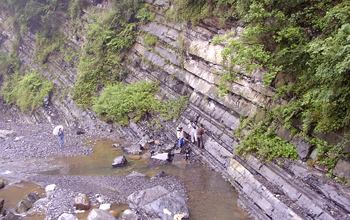Multimedia Gallery
South China Fossils--Possible Terrestrial Origin (Image 1)
Researchers from the University of California, Riverside, study exposures of the Doushanto Formation along a creek in the Yangtze Gorges area of South China.
The UC-Riverside team studied rock samples they collected and found that the first animal fossils in the paleontological record are preserved in ancient lake deposits, not in marine sediment. This discovery dispels the theory that animal evolution began in the ocean, with animal life adapting to terrestrial environments much later in the Earth's history.
The research focused on South China's Doushantuo Formation, a bed of highly preserved fossils dating to about 600 million years ago. While the beds lack adult fossils, many of the fossils appear as bundles of cells that some researchers interpret to be animal embryos.
The researchers collected hundreds of rock samples from several locations in South China, then performed mineralogical analysis on them using X-ray diffraction. They also collected and analyzed other types of geochemical data.
"All our analyses show that the rocks' minerals and geochemistry are not compatible with deposition in seawater," said Tom Bristow, who works in the lab of UC-Riverside geology professor Martin Kennedy. Kennedy's participation in this research was supported in part by a grant from the National Science Foundation (NSF). Bristow adds, "Moreover, we found [the clay mineral] smectite in only some locations in South China, and not uniformly as one would expect for marine deposits. This was an important indicator that the rocks hosting the fossils were not marine in origin. Taken together, several lines of evidence indicated to us that these early animals lived in a lake environment."
To read more about this research, see the UC-Riverside news story Earliest animals lived in a lake environment, research shows. [Research supported by NSF grants EAR 03-45207 and EAR 03-45642.] (Date of Image: 2007-09) [Image 1 of 3 related images. See Image 2.]
Credit: M. Kennedy, UC-Riverside
See other images like this on your iPhone or iPad download NSF Science Zone on the Apple App Store.
Images and other media in the National Science Foundation Multimedia Gallery are available for use in print and electronic material by NSF employees, members of the media, university staff, teachers and the general public. All media in the gallery are intended for personal, educational and nonprofit/non-commercial use only.
Images credited to the National Science Foundation, a federal agency, are in the public domain. The images were created by employees of the United States Government as part of their official duties or prepared by contractors as "works for hire" for NSF. You may freely use NSF-credited images and, at your discretion, credit NSF with a "Courtesy: National Science Foundation" notation.
Additional information about general usage can be found in Conditions.
Also Available:
Download the high-resolution JPG version of the image. (1 MB)
Use your mouse to right-click (Mac users may need to Ctrl-click) the link above and choose the option that will save the file or target to your computer.



